Quest Diagnostics Bundle
How Does Quest Diagnostics Conquer the Healthcare Market?
Quest Diagnostics, a titan in diagnostic information services, relies heavily on its sales and marketing prowess to thrive. Imagine the impact of expanding into consumer-initiated testing, a strategic move that redefined their market reach. Founded in 1967, the company has evolved from serving healthcare providers to becoming a household name. This evolution showcases the power of adaptive sales and marketing strategies.
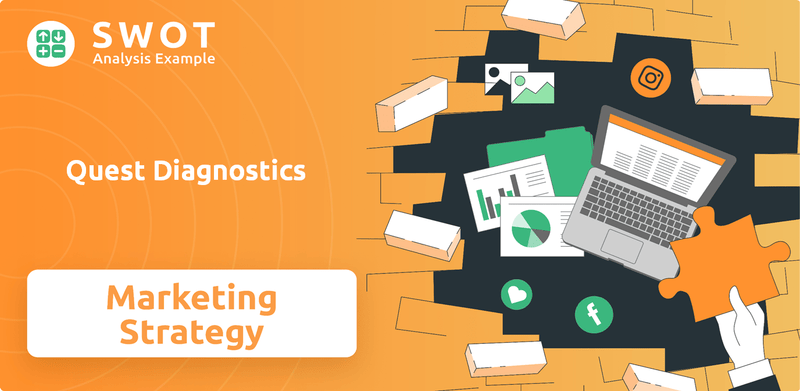
This exploration delves into Quest Diagnostics' customer service delivery, marketing tactics, and brand positioning. We'll dissect their recent campaigns and analyze their Quest Diagnostics SWOT Analysis to understand their competitive advantage. The analysis will cover their sales and marketing approach, including their digital marketing initiatives and patient engagement strategies, to provide a comprehensive view of their business model and growth strategies. Understanding Quest Diagnostics' market share analysis and customer acquisition strategies is essential for anyone seeking insights into the healthcare industry.
How Does Quest Diagnostics Reach Its Customers?
The sales channels employed by Quest Diagnostics are multifaceted, designed to reach a diverse customer base effectively. The company strategically utilizes a combination of traditional and digital approaches to maximize market penetration and customer engagement. This comprehensive strategy reflects the evolving healthcare landscape and the increasing importance of digital solutions.
Historically, direct sales teams have been a cornerstone of Quest Diagnostics’ sales strategy, focusing on building relationships with physicians, hospitals, and managed care organizations. These teams secure and maintain service contracts, which remain vital for institutional clients. Complementing this, the company’s physical retail locations, primarily patient service centers, offer direct patient interaction and sample collection. These centers provide convenient access for patients needing diagnostic services.
Quest Diagnostics has significantly shifted towards digital adoption in its sales channels. The company's website and online platforms are used for patient scheduling, test ordering, and result delivery. This move aligns with the broader trend towards digital health solutions. The introduction of consumer-initiated testing represents a strategic shift towards a direct-to-consumer (DTC) model, supplementing its traditional third-party referral system.
Direct sales teams are crucial for securing large institutional clients, focusing on building relationships with physicians, hospitals, and managed care organizations. These teams are essential for maintaining service contracts and driving revenue growth. This offline channel remains a cornerstone of the company's sales efforts.
Patient service centers provide direct patient interaction and sample collection, offering convenience and accessibility. These centers are a vital touchpoint for patients needing diagnostic services. They support the company's customer acquisition strategies.
The company website and online platforms are used for patient scheduling, test ordering, and result delivery. This reflects a broader industry trend towards digital health solutions. Digital platforms enhance patient engagement strategies.
Consumer-initiated testing allows individuals to order tests directly online, representing a strategic move towards a direct-to-consumer (DTC) model. This complements its traditional third-party referral system. This approach expands the company's reach.
Quest Diagnostics strategically partners with health systems and employers to expand its reach, contributing significantly to growth and market share. These partnerships integrate Quest's services into broader healthcare ecosystems and corporate wellness programs. This approach leverages the company's competitive advantage.
- Partnerships with health systems and employers.
- Integration into broader healthcare ecosystems.
- Expansion of market share through collaborative efforts.
- Focus on corporate wellness programs.
The company's sales strategy is further enhanced by strategic partnerships with health systems and employers, contributing to growth and market share. These collaborations integrate Quest's services into broader healthcare ecosystems and corporate wellness programs, expanding its reach. For a deeper understanding of how Quest Diagnostics generates revenue, consider reading about Revenue Streams & Business Model of Quest Diagnostics. In 2024, Quest Diagnostics reported revenues of approximately $9.6 billion, demonstrating the effectiveness of its multifaceted sales approach and strong market position. The company's ability to adapt and innovate within the healthcare sector is key to its continued success. Quest Diagnostics' focus on both traditional and digital channels, combined with strategic partnerships, allows it to maintain a strong presence in the market and meet the evolving needs of its target audience.
Quest Diagnostics SWOT Analysis
- Complete SWOT Breakdown
- Fully Customizable
- Editable in Excel & Word
- Professional Formatting
- Investor-Ready Format
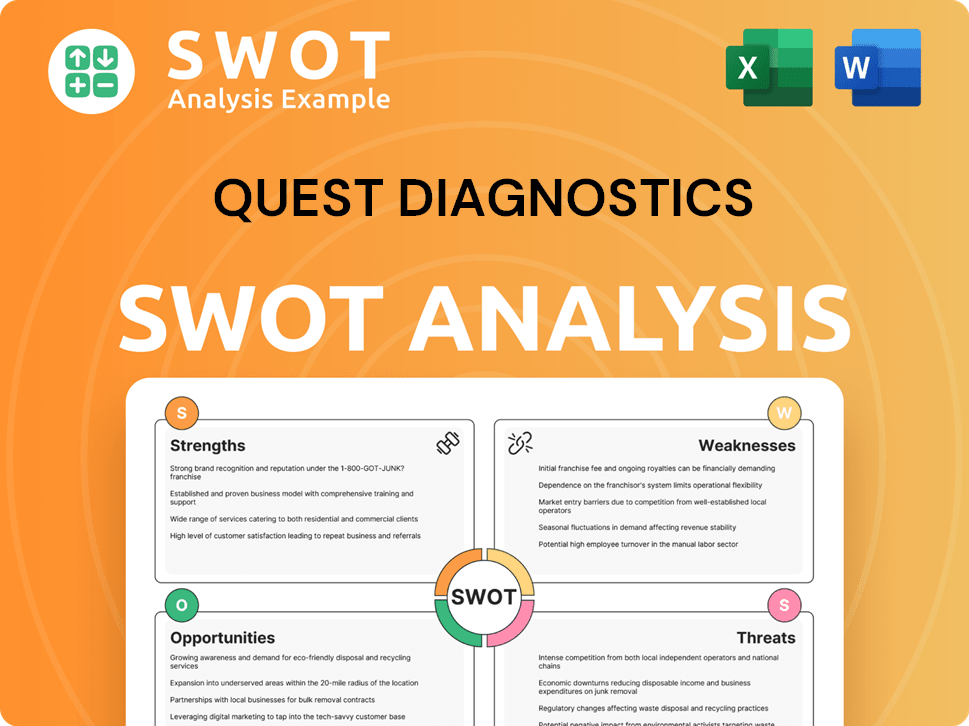
What Marketing Tactics Does Quest Diagnostics Use?
The marketing tactics employed by Quest Diagnostics are multifaceted, designed to enhance brand visibility, generate leads, and boost sales. Their approach integrates both digital and traditional marketing strategies, aiming to reach a diverse audience including patients, healthcare providers, and other stakeholders. This comprehensive strategy is continually refined through data-driven analysis and customer segmentation.
Quest Diagnostics' marketing efforts are heavily reliant on digital channels. They use their website and health portals to provide educational content, which is a key component of their content marketing strategy. This approach is complemented by search engine optimization (SEO) to ensure high visibility in online searches and paid advertising campaigns that target specific demographics.
The company also employs email marketing for patient engagement, sending appointment reminders and sharing health insights. While traditional influencer partnerships are not the primary focus, they collaborate with medical experts and healthcare organizations to build credibility. Social media platforms are also utilized for brand awareness and patient education. Furthermore, Quest Diagnostics is increasingly expanding its direct-to-consumer marketing efforts to adapt to the evolving healthcare landscape.
Quest Diagnostics leverages digital channels extensively to reach its target audience. This includes content marketing through its website, SEO to improve online visibility, and paid advertising campaigns.
Content marketing is a cornerstone of their strategy, with educational resources provided on their website. SEO is crucial for ensuring that Quest Diagnostics appears prominently in search results when potential customers seek health information.
Paid advertising, including SEM and display ads, targets specific demographics and healthcare professionals. Email marketing is used for patient engagement, appointment reminders, and sharing health insights.
Traditional marketing methods, such as print advertisements in medical journals and participation in industry events, are still employed to reach healthcare providers. These tactics complement the digital strategies.
Quest Diagnostics emphasizes data-driven marketing, utilizing customer segmentation to tailor messages and personalize communication based on patient needs and physician specialties. Analytics tools track campaign performance and customer engagement.
The company is expanding its direct-to-consumer marketing efforts, adapting to a more consumer-centric healthcare landscape. This shift reflects a strategic response to changing market dynamics.
Quest Diagnostics' approach to marketing is comprehensive and data-driven, enabling them to effectively reach their target audience and drive sales. The company's focus on digital marketing, combined with traditional methods and a strong emphasis on data analytics, positions them well in a competitive market. For more insights into their overall strategy, including their Growth Strategy of Quest Diagnostics, it is worth exploring further.
Quest Diagnostics employs several key marketing strategies to build brand awareness and drive sales. These strategies are designed to reach a broad audience and adapt to changes in the healthcare market.
- Digital Marketing: Content marketing, SEO, paid advertising, and email campaigns.
- Traditional Marketing: Print ads in medical journals and participation in industry events.
- Data-Driven Marketing: Customer segmentation, personalized communication, and analytics.
- Direct-to-Consumer Marketing: Expanding efforts to reach consumers directly.
Quest Diagnostics PESTLE Analysis
- Covers All 6 PESTLE Categories
- No Research Needed – Save Hours of Work
- Built by Experts, Trusted by Consultants
- Instant Download, Ready to Use
- 100% Editable, Fully Customizable
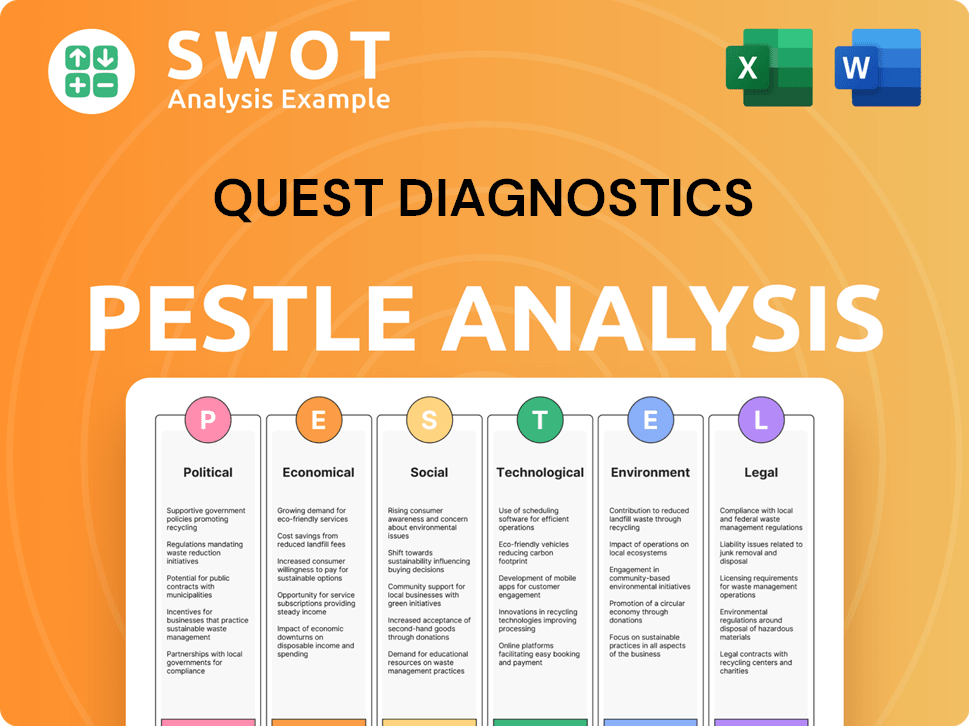
How Is Quest Diagnostics Positioned in the Market?
The brand positioning of the company centers on its role as a trusted leader in diagnostic information services. It emphasizes accuracy, innovation, and accessibility to empower better health outcomes. The core message focuses on providing actionable insights derived from comprehensive testing. This approach is crucial for their Quest Diagnostics sales strategy and overall market presence.
Its visual identity typically reflects professionalism and reliability, often using clean designs and medical imagery. The tone of voice is authoritative yet empathetic, aiming to build confidence among healthcare providers and patients. This carefully crafted brand image is essential for effective Quest Diagnostics marketing strategy.
The company differentiates itself through an extensive test menu, including specialized molecular and gene-based testing. This appeals to its target audience by showcasing scientific excellence and comprehensive solutions. Their commitment to quality and patient care is a key unique selling proposition, supporting their Quest Diagnostics business model.
The company offers a vast array of tests, including specialized molecular and gene-based diagnostics. This comprehensive menu allows them to serve a broad range of healthcare needs. This is a key component of their Quest Diagnostics sales and marketing approach.
Quality and patient care are central to the brand's unique selling proposition. The company invests heavily in ensuring accurate and reliable results. This commitment is crucial for maintaining patient trust and confidence, which is essential for their success in the healthcare market.
Consistency is maintained across all channels, from patient service centers to online platforms. This ensures a cohesive customer experience. Consistent branding is vital for building and maintaining brand recognition and trust, which is a focus of their Quest Diagnostics marketing plan for healthcare.
The company continuously invests in new technologies and expands its service offerings to improve the patient experience. This includes simplified online scheduling and result access. This focus on innovation is key to staying competitive and meeting evolving market demands.
The company's brand positioning is also influenced by its response to shifts in consumer sentiment and competitive threats. They continuously invest in new technologies, expand service offerings, and enhance the patient experience. For example, they have focused on simplifying online scheduling and result access. The company's ability to adapt and innovate is a critical aspect of its Quest Diagnostics market analysis and long-term success. For more insights into the company's history and evolution, consider reading the Brief History of Quest Diagnostics.
Quest Diagnostics Business Model Canvas
- Complete 9-Block Business Model Canvas
- Effortlessly Communicate Your Business Strategy
- Investor-Ready BMC Format
- 100% Editable and Customizable
- Clear and Structured Layout
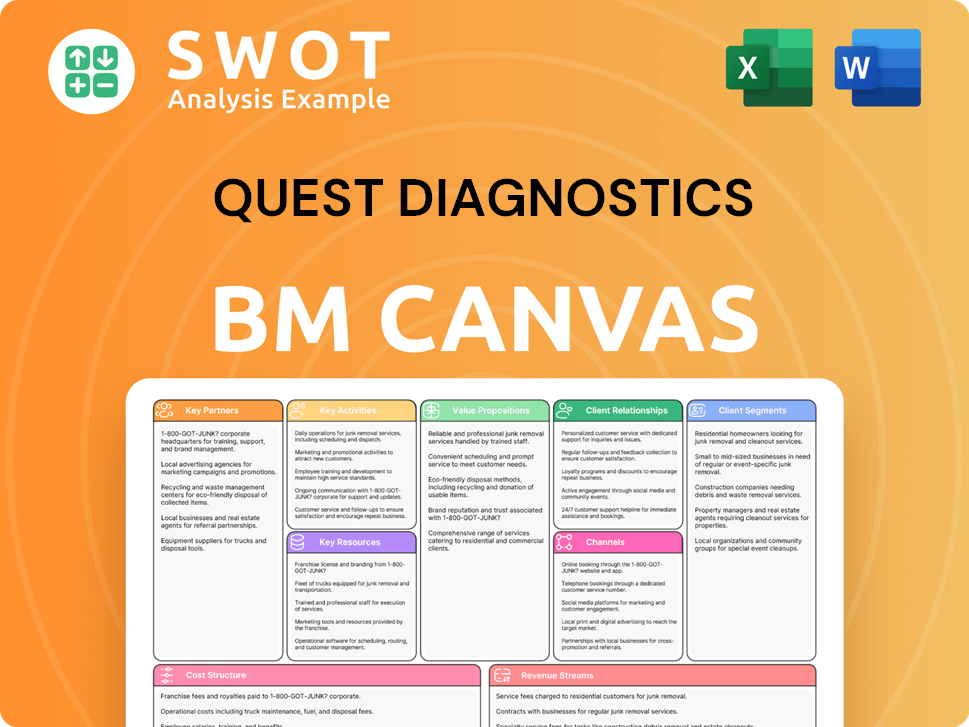
What Are Quest Diagnostics’s Most Notable Campaigns?
Historically, Quest Diagnostics' sales strategy and marketing efforts have been significantly shaped by campaigns promoting new diagnostic tests and expanding service accessibility. These campaigns often focus on direct-to-consumer testing options, such as those for general wellness or specific health concerns. The primary goal is to increase patient engagement, drive self-referrals, and broaden market reach beyond traditional physician channels.
Creative concepts for these campaigns emphasize convenience, empowerment, and proactive health management. The marketing strategy is primarily executed through digital channels, including social media, targeted online advertisements, and email marketing, supplemented by public relations efforts. The results of these efforts have shown increased website traffic and higher rates of online test orders, enhancing brand visibility among the general public. These initiatives are crucial in a competitive healthcare market.
Key campaigns often involve collaborations with health organizations or medical professionals to boost credibility and brand awareness, reinforcing Quest Diagnostics' position as a reliable healthcare partner. These campaigns are essential for maintaining and growing market share. In recent years, the company has focused on digital marketing initiatives to reach a wider audience and improve customer acquisition strategies.
Quest Diagnostics heavily utilizes digital marketing, including SEO, social media, and targeted online advertising. These initiatives aim to improve brand awareness and drive traffic to their website. They also focus on patient engagement strategies to encourage self-referrals and increase the demand for their services.
Partnerships with healthcare providers and organizations are a key part of Quest Diagnostics' marketing plan for healthcare. These collaborations help to build credibility and expand their reach within the medical community. These alliances are crucial for improving patient outcomes and driving revenue generation.
One of the most significant campaigns involves direct-to-consumer (DTC) testing. This approach allows individuals to order tests directly, focusing on convenience and proactive health management. The goal is to expand the market reach and increase patient engagement by making healthcare more accessible. The DTC market is experiencing significant growth, with a projected value of over $8 billion by 2025, according to recent market analysis reports.
Social media campaigns are a core component of Quest Diagnostics' digital marketing initiatives. These campaigns often focus on health education, promoting new tests, and engaging with potential customers. These efforts are designed to increase brand awareness and drive traffic to the company's website, contributing significantly to their customer acquisition strategies.
Quest Diagnostics uses targeted online advertising to reach specific demographics and promote relevant tests. This approach allows them to focus their marketing budget allocation effectively and improve the conversion rates of their campaigns. By targeting the right audience, the company can maximize its sales process optimization.
Public relations efforts and media outreach are used to build brand awareness and credibility. Collaborations with healthcare professionals and organizations are a key part of this strategy. These efforts help to position the company as a trusted healthcare partner and enhance its competitive advantage in the market.
Educational campaigns are designed to inform the public about various health conditions and the tests available to diagnose them. These campaigns often feature collaborations with medical experts and aim to empower individuals to take control of their health. By providing valuable information, Quest Diagnostics strengthens patient engagement strategies.
Email marketing is an important tool for nurturing leads and engaging with existing customers. This strategy involves sending targeted messages about new tests, health tips, and promotional offers. Email campaigns contribute to revenue generation by driving repeat business and encouraging self-referrals. Email marketing has a significant impact on the overall sales process optimization.
Quest Diagnostics Porter's Five Forces Analysis
- Covers All 5 Competitive Forces in Detail
- Structured for Consultants, Students, and Founders
- 100% Editable in Microsoft Word & Excel
- Instant Digital Download – Use Immediately
- Compatible with Mac & PC – Fully Unlocked
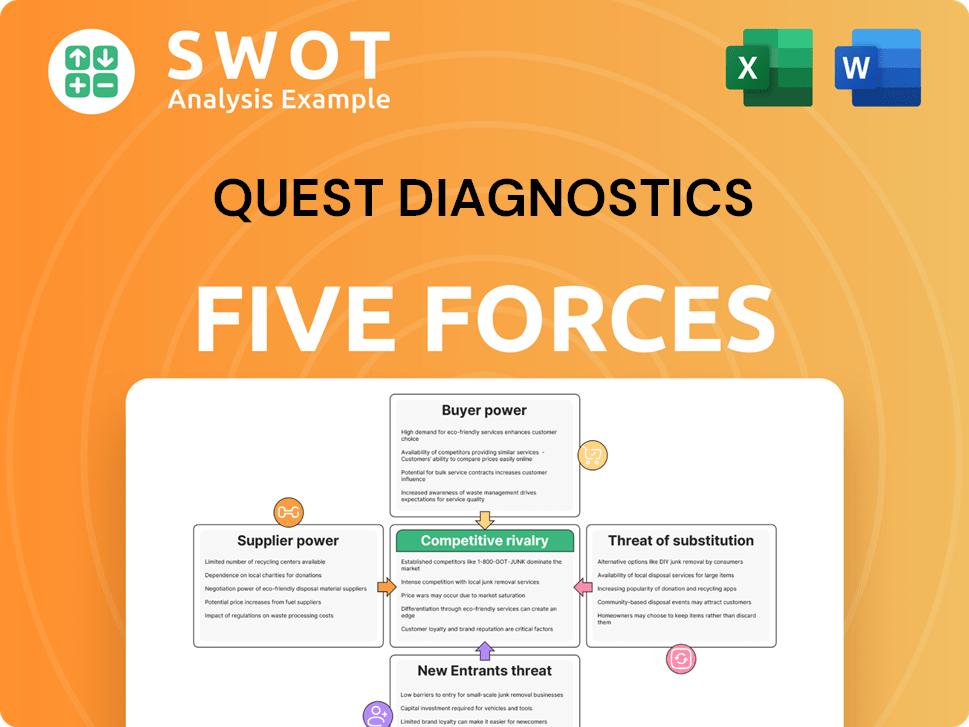
Related Blogs
- What are Mission Vision & Core Values of Quest Diagnostics Company?
- What is Competitive Landscape of Quest Diagnostics Company?
- What is Growth Strategy and Future Prospects of Quest Diagnostics Company?
- How Does Quest Diagnostics Company Work?
- What is Brief History of Quest Diagnostics Company?
- Who Owns Quest Diagnostics Company?
- What is Customer Demographics and Target Market of Quest Diagnostics Company?
Disclaimer
All information, articles, and product details provided on this website are for general informational and educational purposes only. We do not claim any ownership over, nor do we intend to infringe upon, any trademarks, copyrights, logos, brand names, or other intellectual property mentioned or depicted on this site. Such intellectual property remains the property of its respective owners, and any references here are made solely for identification or informational purposes, without implying any affiliation, endorsement, or partnership.
We make no representations or warranties, express or implied, regarding the accuracy, completeness, or suitability of any content or products presented. Nothing on this website should be construed as legal, tax, investment, financial, medical, or other professional advice. In addition, no part of this site—including articles or product references—constitutes a solicitation, recommendation, endorsement, advertisement, or offer to buy or sell any securities, franchises, or other financial instruments, particularly in jurisdictions where such activity would be unlawful.
All content is of a general nature and may not address the specific circumstances of any individual or entity. It is not a substitute for professional advice or services. Any actions you take based on the information provided here are strictly at your own risk. You accept full responsibility for any decisions or outcomes arising from your use of this website and agree to release us from any liability in connection with your use of, or reliance upon, the content or products found herein.